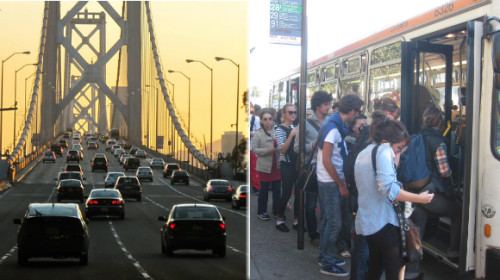Report: Millennials less in love with the car than previous generations

If a person is born after 1980, it’s likely he or she doesn’t view having a car as “freedom,” but would rather be free from having to drive a car at all. And the best way California can adapt to this trend might not necessarily be expanding highways but instead building more public transportation options and keeping our existing infrastructure in good order.
That’s the point of a recent report from CALPIRG, Millennials in Motion, which dives into the transit habits of the 18-34 set to explain why our transportation future should incorporate these trends into planning.
Certainly as we’ve discussed before, if California wants to stay competitive it needs to keep a skilled workforce here in the state to fill in-demand jobs and start their own companies. We’ve delved into the “What Millennials want” topic which includes affordable housing and being able to get around via walking, biking and snagging a ride on public transit.
The CALPIRG report gives good roundup of studies showing Millennials are simply less car-centric. It’s not just about hopping on a train into town on the weekend. They’re less likely than previous generations to take a car to work or school, said one study by the Urban Land Institute. That data also showed 20 percent of Millennials take public transportation once a week or more, compared to Generation X at 7 percent and Baby Boomers at 10 percent. And the National Household Travel Survey showed that young drivers in 2009 took 15 percent fewer trips than the young drivers of 2001.
As to why this is happening, the CALPIRG report authors say the Great Recession likely inhibited car usage and the generation also has never faced a time without high gas prices. That’s a constant reminder of the cost of owning a car and they can’t say they–as I confess that I have lamentedly–remember when gas was sub-one dollar a gallon.
Other reasons, among others cited was the generation simply prefers walkable, city living, as opposed to a suburban, car-centric lifestyle. The cohort is also the most digitally connected which means, with more activities being done online and being able to hitch a ride on Uber or Lyft, there are fewer car trips and the trips are shorter.
One takeaway from the report is cities, regions and states should be integrating these transit trends into planning, come up with most likely scenarios in order to spend already tight resources to get the biggest return on investment. The report authors argue that doesn’t necessarily mean big highway expansions which don’t always reduce congestion, as they can spur more development outward and thus more trips and traffic. Also, by the time they’re done, populations can blow up beyond expectation.
The Los Angeles metro area represents a grand-scale laboratory for transit policy. After the completion of the I-405 Sepulveda Pass project, which spawned Carmaggedon and its sequel, preliminary data (again, still early days) showed some complicated results, even slowing of commute times. On the other hand, there are five public transit lines under construction in the region, also at great expense. But, based on these Millennial transportation habit studies, those rail projects, when combined with affordable, transit-oriented housing, may be one of the better investments the region may make. The report argues that a better return-on-investment will be to keep existing infrastructure well maintained and start investing more in public transit and other options:
“Cities across the country are already taking action to capitalize on the increased demand for transportation options among Millennials—expanding bicycling infrastructure, adding late-night transit service, providing access to and appropriate regulation for carsharing and ride-sourcing providers, and encouraging residential development in areas where Millennials and others increasingly want to live.”
Keeping that trend going statewide will help California to stay competitive. It’ll take some regional collaboration to come up with comprehensive infrastructure and housing plans. The Summit’s Infrastructure Action Team has been encouraging lawmakers and officials since the beginning of the Summit project to do just that:
More long-term funding
California needs to find sustainable ways to fund the long-term infrastructure needs. State and federal gas taxes in their current state struggle to adequately fund infrastructure and will only do a worse job if young generations continue to drive less and less.
The state handed local officials a powerful tool for paying for infrastructure and other projects when Gov. Brown signed legislation that enhances the Infrastructure Financing District funding model. The Summit helped expand the funding that could be made available and created a guide for how the Districts could be used.
The state Legislature’s cap-and-trade funding deal will provide $100 million this year to multi-family housing development and at least 35 percent of all future cap-and-trade revenues to transit, affordable housing, and sustainable communities–a source of funding totaling $1 billion annually.
Smarter, long-term funding
The Summit has made a priority legislation in California that not only funds infrastructure but does it sustainably. One way is to fully implement the state’s SB375 “sustainable communities” legislation. The law requires communities to come up with plans for growing in terms of population and economic activity in a sustainable way. The Economic Summit held a longer discussion about delivering on the promise of SB375 at this year’s Capitol Day in Sacramento (video).
Look out in the coming months for more infrastructure priorities on the Summit’s to-do list for 2015.
And now the big question: What do you think? Do you want to be free of a car or at least leave your car in your parking spot most of the time? Should planning Let us know in the comments or on Facebook or Twitter.
Originally published on CAeconomy.org.

Dr. Ansari on health care’s future amid demographic shifts
Original story on permanente.org During a recent CEO workgroup panel, “Advancing Your Culture…
December 23, 2024
Drs. Hoberman and Nguyen on preparing for health care AI
Original story on permanente.org Many questions surround the advancements of artificial intelligence in…
October 30, 2024